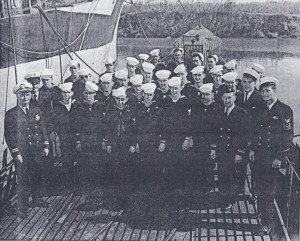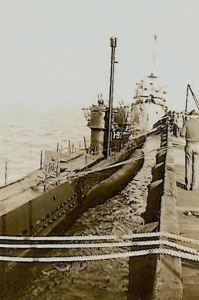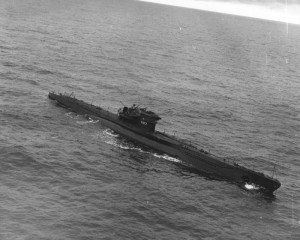World War II was a horrific global conflict which took place from September 1939 to September 1945 and involved a majority of the world’s nations. The War in Europe came to an end in May of 1945 with the surrender of the last German forces still fighting. Adolf Hitler, Nazi Germany’s fanatical leader, had supposedly committed suicide on April 30, 1945 during the Battle of Berlin as Soviet forces closed in on his underground bunker. There was speculation at the time that Hitler was still alive and had somehow escaped from Germany.
At the end of the war, forty-nine German U-Boats were still out on patrol. The word U-Boat is a version of the German word Unterseeboot, and refers to military submarines operated by Germany in World War II. On May 5, 1945 the Kriegsmarine (German Navy) ordered all U-Boats at sea to cease operations and surrender. Most of these U-Boats followed orders and surrendered at ports in the United Kingdom, Norway, Denmark, France, Germany, Canada, and the United States. Four U-Boat crews decided to scuttle (intentionally sink) their submarines close to shore instead of surrendering them. Two other U-Boats refused to follow the surrender orders and decided to escape to South America. This is the story of those two U-Boats and the controversy that ensued seventy years ago.
U-530, a Type IXC/40 long range U-Boat, was in the Atlantic Ocean East of Puerto Rico when the surrender order was received. The U-530 Captain, twenty-five year old Otto Wermuth, decided to escape to Argentina and proceeded to do so arriving at Mar del Plata in Argentina on July 10, 1945. Wermuth had his crew contaminate the oil for the diesel engines with acid on the way into port in an attempt to make the submarine unusable. U-530’s unexpected arrival and surrender to the Argentine Navy caused many rumors to be started. Otto Wermuth did not explain why it had taken him more than two months to arrive, why the crew had dumped overboard parts of the anti-aircraft guns, ammunition, torpedoes, radar equipment, code books, and the log book. In addition, none of the crew, including Wermuth, had any identification.
U-977, a Type VIIC medium range U-Boat, under the command of twenty-four year old Heinz Schaeffer, had left German-occupied Norway on May 2, 1945. Upon receiving the surrender order three days later, Schaeffer and his crew decided to escape to Argentina. Married crew members were given the choice of being dropped off in Norway or continuing to Argentina. Surfacing near Bergen Norway in the early morning hours of May 10, sixteen crew members in inflatable rubber boats were dropped off. These men were later captured by British forces and claimed that they were survivors of the U-977.
U-977 began its epic journey afterwards in a voyage which took 108 days and covered 8,797 miles. For the first 66 days, U-977 travelled underwater without surfacing to avoid being sighted using its schnorchel. Schnorchel, which is the German word for snorkel, was a device used on some U-Boats that was raised, allowing air to enter the boat for the crew and the diesel engines while the submarine was under water at a shallow depth. Also during the voyage, U-977 ran at a reduced speed using only one engine to conserve fuel. On July 14, U-977 finally surfaced and later stopped off of the Cape Verde islands where the stressed out crew went swimming in the ocean and relaxed after being cooped up in the submarine for 66 days. Continuing the voyage on the surface, U-977 arrived at Mar del Plata in Argentina on August 17, 1945 where Schaeffer surrendered the submarine and crew to the Argentine Navy. Unlike U-530, U-977 surrendered with all of its weapons, torpedoes, code books, log book, etc. on board.
More rumors and speculation started around the world when a second U-Boat surrendered in Argentina, and why had the two German U-boats gone to Argentina instead of surrendering as ordered? A Brazilian Navy ship, the Cruiser Bahia, had sunk on July 4, 1945 under mysterious circumstances. At first it was suspected that the U-530 had sank the Bahia, then U-977 was also accused of the sinking; an inquiry months later eventually found that the Bahia had been sunk by an accident during gunnery practice.
An Argentine newspaper at the time claimed that a submarine had surfaced off of the Argentine coast and had landed two people who may have been Adolf Hitler and his wife Eva Braun in disguise. As U-977 had left Norway after Adolf Hitler had supposedly committed suicide, it was rumored that Hitler had been secretly flown out of Germany, brought on board the U-977 in Norway, and dropped off along the coast of South America somewhere.
U.S. Navy Investigators had Otto Wermuth and Heinz Schaeffer taken to a special prison near Washington D.C. for extensive interviews and an investigation. For several weeks Schaeffer was confronted with questions like “You hid Hitler, where is he?” At one point, Wermuth and Schaeffer were put in a room together with hidden microphones to see what they would talk about. Investigators were disappointed when all they talked about were details about their respective voyages. The investigation and resulting report disputed some of Schaeffer’s testimony and parts of the U-977’s log book entries. Also mentioned was Wermuth’s lack of cooperation in giving any information about his orders, the suspicious absence of any identification for Wermuth or any of his crew, the U-530’s missing logbook, and other items.
U-530 and U-977 were cleaned up and brought to the United States by U.S. Navy crews where they were both part of the “Victory Tour” showing off enemy equipment to the public. U-530 was in Houston as one of its stops. Sometime afterwards both U-Boats were sunk by the U.S. Navy as targets. Eventually Otto Wermuth, Heinz Schaeffer, and the two crews were returned to Germany. Schaeffer eventually moved to Argentina where he wrote the book “U-Boat 977”, about his time in the German Navy and the voyage of U-977 to Argentina.
To this day, stories continue that Hitler escaped to South America in a U-Boat. A Soviet investigation claimed that Hitler had shot himself while taking a cyanide pill at the same time and that Hitler’s remaining staff had burned the bodies. Soviet intelligence personnel had discovered two badly burned bodies supposedly of Adolf Hitler and his wife Eva Braun in a bomb crater outside of his bunker in Berlin. After the fall of the Soviet Union in the 1990’s, Russian officials displayed a burned skull fragment with a bullet hole that they claimed was from Hitler. In 2009, DNA results on the skull fragment revealed it was from a woman, fueling yet even more rumors. Also in 2009, the United States National Archives finally released the classified report on U-530.
Assistance with the writing of this article must be credited to the book “U-Boat 977” written by Heinz Schaeffer, the U.S. Navy Historical Center, and numerous other written sources.



